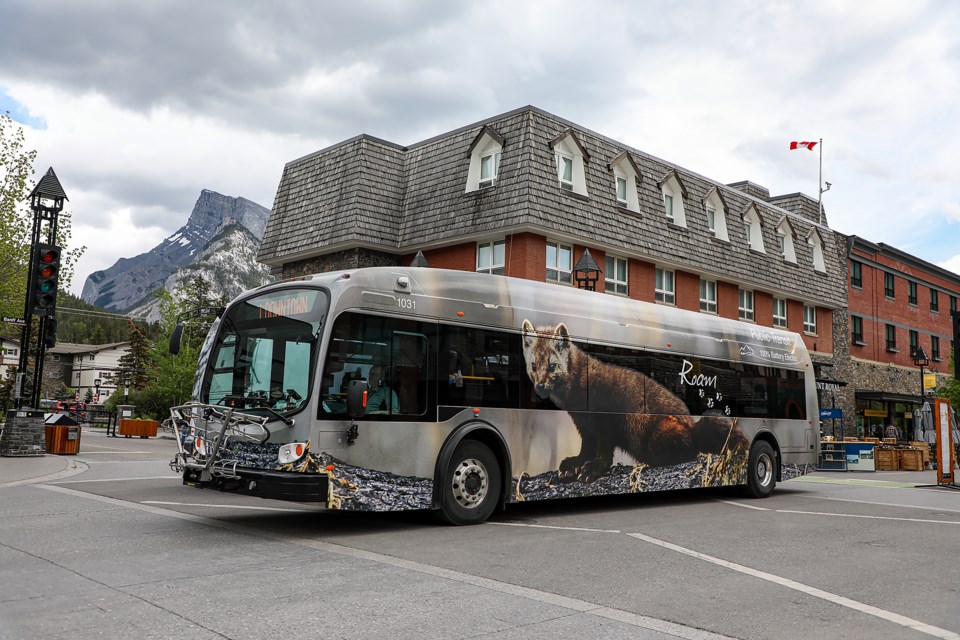BANFF – A new provincial funding program is aiming to support low-income families by subsidizing transit passes.
The province announced $15 million would go towards the initiative, with $9 million being split between Calgary and Edmonton and the remaining $6 million going to other municipalities in Alberta with low-income public transit options.
And while Banff offers free transit to residents and Canmore has free bus transit throughout its municipal borders, both mayors noted it will help low-income people for regional public transit service.
Canmore Mayor Sean Krausert said transit – as well as housing, food prices and childcare – are the four main drivers of costs for local residents.
“If our municipalities are to address these crucial things for everyday life, we absolutely need the support of other levels of government," he said.
"Public transit is absolutely essential in combatting the high cost of living and [the] announcement helps municipal programs for low-income passes do exactly that."
In both Banff and Canmore, the low-income transit pass helps cover 50 per cent of the cost of regional public transit service.
Krausert pointed out the provincial funding will aid the entire Roam system, which in turn will allow existing money set aside for transit to go further in the Bow Valley.
“There’s a certain amount of dollars that allow us to offer free transit. That goes to support everyone, but it also goes to support those that take part in our affordability services program. These dollars allow for the other dollars that would’ve been used for that to go further,” he said.
“It bolsters and entrenches the low transit pass to provide the service and it allows us to be able to offer on our regional services, which are not free, so it allows it to continue and perhaps expand. There’s a net benefit to both communities and regionally.”
Banff Mayor Corrie DiManno noted “Banff has long been an advocate for supporting low-income transit,” having first offered its own such pass in 2007.
She said they see about 500 people a year using the pass for transit.
Alison Gerrits, Banff’s director of community services, said the Town purchases 10-ride passes, monthly passes and return trip regional passes. The Town then issues those to people eligible for its access program at a 50 per cent discount.
She said it is yet to be determined what the municipality would receive, but it would aid local residents and the Town.
According to statistics from the Town of Canmore, there were 365 Roam cards sold in 2022. Of those, 250 were low-income, which accounted for 68 per cent of total sales. The ultimate cost to the Town was $9,030.
Jeremy Nixon, the Minister for Seniors, Community and Social Services, said eligible municipalities will be notified and be able to go through an application process.
The exact amount for each municipality will be determined through the process, and Nixon said the intent was to have money reach each area as quickly as possible.
A media release noted low-income transit pass programs in Calgary and Edmonton helped close to 390,000 residents. In addition to helping areas such as Banff and Canmore, other municipalities with low-income transit passes such as Grande Prairie, Cold Lake, Airdrie and Cochrane are eligible.
In the Bow Valley, Roam transit has continued to grow as the Bow Valley Regional Transit Service Commission members have prioritized public transit as an option for visitors and residents.
It has also been aggressive in transitioning its fleet away from fossil fuel-run buses to electric. It is anticpated 10 of the commission's 32 buses are to be electric by this summer.
In March 2022, Roam and Parks Canada signed a $12.9 million five-year agreement to help purchase three new electric buses to reduce car use and road emissions.
Banff council also approved purchasing two new electric buses at its 2023 service review to help its Route 1 local service frequency increase from every 20 minutes to 15 minutes.
DiManno pitched the potential of free regional public transit for local residents, but discussion was put off until at least 2024 service review.
The idea was received lukewarmly by fellow Roam members Canmore and Lake Louise, who opted to focus on local routes before possibly expanding regional routes.
The regional service between Banff and Canmore will expand before the spring with an extra 4.5 service hours each weekend day to match weekday services. Once running, the last bus will leave at 11:15 p.m. in Banff and Canmore at 11:45 p.m.
Banff is scheduled to undergo a fare review in 2023 after previously having done one in 2018. Canmore will also go through a service review, and is expected to return to the transit commission before the end of 2023 for potential recommendations.
Canmore is also expected to have a regional bus to Grassi Lakes in 2024 as part of a three-year pilot, with much of the funding coming from the province.
Banff-Kananaskis MLA Miranda Rosin said Roam transit has had a “pivotal role” in helping the region manage the high visitation and congestion rates in the valley.
The Banff Bow Valley People-Moving framework was released in December, with the expert panel recommending more investment in public transit.
The report noted the importance of reducing greenhouse gas emissions and the potential of expanding bus service into Kananaskis Country.
Roam had record ridership last year with 1.65 million riders, which was an 8.5 per cent increase compared to the previous record in 2019.
“Transit is essential for many purposes, including commuting to work, attending medical appointments, picking up groceries or travelling for recreational activities,” said Roam CAO Martin Bean. “It needs to be accessible for all, frequent, reliable and, of course, affordable.”




